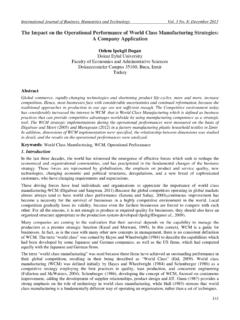Transcription of Insurer of the future - EY
1 Insurer of the futureAugust 20162| Insurer of the future3 Insurer of the future | The Indian insurance industry continued on its transitional journey in the past year. The highlight was increased M&A activity during the year, with the majority of foreign partners increasing stakes in their Indian joint ventures following the increase in the foreign direct investment limit from 26% to 49%. Changes in reinsurance regulations also resulted in almost all foreign reinsurers currently operating in the Indian market applying for branch licenses, with some interest even from domestic companies. The pension sector has also received a lot of interest and is slated to come up in a big way. These overwhelming responses underpin the inherent potential within the Indian insurance market despite the challenges. The insurance industry is now moving into the next phase of having public ownership, with initial public offerings (IPO) expected in both life and general insurance segments.
2 While this phase will bring its own set of challenges due to greater transparency and compliance requirements, it will also provide an opportunity to easily assess and realize gains from efficient management. This phase will coincide with a period of transition globally, in how businesses operate, due to changing customer behavior, changing market dynamics and the increasingly important role of Confederation of Indian Industry (CII) and EY bring you this report with a futuristic take on what Indian Insurer version may look like to tackle the changing scenario. ForewordRohan Sachdev Global Insurance Emerging Markets LeaderPartner and Leader - Financial Services AdvisoryEYNarendra Ganpule Partner - Financial Services AdvisoryEYChandrajit BanerjeeDirector GeneralConfederation of Indian Industry4| Insurer of the future5 Insurer of the future | ContentsExecutive summary 6 Insurer of the future 8 Digital: an enabler and a disruptor 18 Expanding frontiers for reinsurance in India 28 GST: A new paradigm for insurance operating model 326| Insurer of the futureExecutive summary7 Insurer of the future | Predicting the future may be hard, but preparing for it is necessary.
3 The Indian insurance industry is facing a number of challenges such as low customer penetration, inadequate insurance coverage, misfiring distribution channels, onerous claims management framework, decreasing interest rates and an evolving regulatory framework. Additionally, businesses globally are being disrupted, raising the demand and expectation of customers. While there is no denying the underlying potential of the Indian insurance market, insurers need to respond to these challenges and changes to continue to remain relevant in the future . The future of insurance in India looks not only exciting but also transformative. Insurers will need to evolve the way they do business across operations to become more: Customer-centric through increased customer segmentation, offering customized innovative products and using technology to be better connected with the customer Data savvy and automated across all processes, including product development, sales, underwriting, claims management and business monitoring Open and innovative partnering organizations Strong in the core insurance business by using the latest risk management tools and techniques Flexible and cost efficient by adopting technology and consolidatingTechnology will form the backbone for this transformation, acting as both an enabler and a disruptor.
4 Its role is expected to rapidly change from its current ancillary function to becoming a core competency for insurance businesses. While solutions such as data analytics, robotics process automation, blockchain and cloud are already being implemented, we are currently only seeing the tip of the iceberg in terms of their potential applications and overall ability to transform businesses. A new Executive summarywave of insights, interactions and value is bringing insurers and customers closer. Leveraging the power of digital insurance is no longer simply about incorporating technologies into the organization, but also about reinventing the organization and the culture within it. The digital bar for insurers is rising continuously, and the companies that can meet this challenge will build greater customer loyalty, improve cost efficiency and increase one of the biggest fiscal changes for the country is potentially another trigger for the transformation of insurance business operations in the more immediate future .
5 The impact of GST on insurance companies will not be restricted to the finance function. It will have far-reaching consequences, particularly on the selection of optimal pan-India business models. From the current practice of dealing with a single tax-administering authority, things are about to get a bit more complex for service providers with the emergence of the center and states as dual stakeholders, and the calculation of input and output tax credits separately for each individual state in which they are reinsurance industry is also undergoing a major change, with foreign insurers being permitted to set-up branch offices in India. The new rules are expected to create an even greater focus on services by foreign insurers as they compete for a share of the market. The market for emerging risks such as cyber insurance, customized liability insurance and specific disease insurance is expected to grow, driven by the willingness of customers to pay a premium for specialized and innovative solutions.
6 Reinsurers have a key role to play in helping the insurance industry innovate and cover new frontiers, as the industry looks to them when it comes to exploring the | Insurer of the futureInsurer of the future19 Insurer of the future | Insurer of the futureThe way businesses are run globally is undergoing a complete overhaul. Technology is giving people the power to challenge each and every aspect of traditional businesses without being restricted by practical implementation considerations of the suggested improvements. Disruption has truly become the buzz word of current times. Financial services have historically been guilty of not being very customer-centric. However, with the onset of the start-up culture, the global financial services industry is undergoing significant modernization to remain relevant in this day and age.
7 The Indian insurance industry has been going through some choppy waters in recent years, struggling to grow at the projected rates. After the life insurance sector opened up to private players, it grew at a CAGR of around 20% between FY01 and FY16. However, this growth was a story of two phases: the CAGR was a staggering 31% for the first nine years, followed by a much more modest growth of 4% for the next six years. As a result, life insurance penetration in India has declined to levels similar to 10 years ago. While the non-life insurance industry has grown more uniformly, at a CAGR of 15% for the past 10 years, the relatively flat insurance penetration indicates this has been more or less in line with economic growth rather than through increased penetration. The stunted growth has created a whole host of other issues, including expense inefficiencies and lower-than-expected insuranceSource: IRDAI Annual ReportFirst Year (INR crs) Life insuranceSource: IRDAI Annual Year PremiumPenetrationPremiums (INR crs) 10| Insurer of the futureAs Indian insurers realign their strategies in the backdrop of the current domestic market dynamics and continually changing insurance operations landscape globally, there is a possibility of them radically changing their current operating models.
8 Based on the current challenges facing the industry and the new technologies available, we attempt to gaze into the crystal ball to predict the characteristics insurers of the future should have. We elaborate each of these characteristics with corresponding sample solutions, some of which are already being implemented globally as well as in India. The future of the industry will depend on whether insurers can break traditional mind-sets and really turn challenges into opportunities; with the technologies at hand, the possibilities can truly be analyze the way forward, it is important to look at the current challenges faced by the Indian insurance industry. Successfully addressing these challenges will be key to generating future opportunities for insurers. Savings-oriented market India, like a number of other Asian markets, is savings-oriented, reflecting the general mind-set of the population.
9 The protection market is still at a relatively nascent stage despite insurance being present in India for decades, as people generally expect tangible returns for any money paid. This is reflected in the fact that the return-of-premium variants of protection products such as term insurance are equally popular in India than the base version offering no guaranteed payback. The majority of insurance purchases in India are still driven by tax savings. This savings orientation also results in insurance companies constantly competing with other savings solutions providers such as mutual funds and banks for the same pie of the customers persistency is one of the key issues plaguing the Indian insurance industry. This is particularly an issue with life insurance, where usually less than half the policies sold survive beyond the second policy year.
10 One of the key reasons behind poor persistency is inappropriate selling, whereby products are sold by distributors in search of the highest commission rather than by mapping the customers needs. Insurance products offering long-term savings and protection solutions are also incorrectly pitched to customers as alternatives for short-term investment solutions. The customers in this case usually lapse their policies after paying their first attrition is another key reason for low policy persistency as it affects policy servicing. There is also the possibility of agents churning their portfolio continually by wrongly advising customers to lapse existing policies to purchase new one from challenge for insurance companies is getting customers to cover their multiple insurance needs from them. Companies have generally struggled with low ratio of policies per customer, indicating that they are not being able to capture a bigger share of the customers penetrationIndia has significantly lower insurance penetration than other developing markets.















